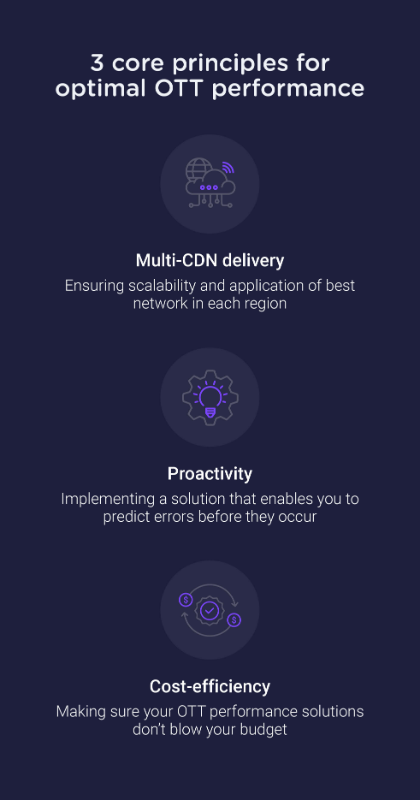
With competition in the streaming market heating up, maintaining a high level of OTT performance is an absolute must. Otherwise, the failure of even just one component to perform can set off a vicious chain reaction: technical issues cause delivery errors or increase your buffer ratio, leading to lower viewer satisfaction and your brand taking a hit, and, ultimately, subscriber churn (even those watching for free). In other words, the success of your streaming service depends on how well you keep up OTT performance 24/7.
Preparation to improve OTT performance is paramount
Preventing user churn is at the heart of all streaming operations. Of course, that’s easier said than done. Ensuring a high level of OTT performance, which equates to top-notch QoE, requires operations engineers to have a system for collecting and displaying data which clearly enables them to dig in and identify the issues. For many operations teams, though, that system is often cobbled together over time with little thought as to the end result. Additionally, changes to the delivery architecture or workflow are layered into whatever tools are used for operational support. The result is that there is often little connection between some of the critical KPIs for OTT performance:
- Rebuffer ratio
- Stream failure
- Cache misses
- Extensive bitrate shifts
Most operations engineers know that the data behind those, and other KPIs are found across multiple components. Downstream, upstream, everything is linked in a complex web. However, without the ability to see the whole picture at once, solving the issues before they lead to subscriber churn is very time-consuming. So part of the success of operations is to properly prepare.
The three principles of perfecting OTT performance

Let’s pretend that you have a blank slate for operationalising your streaming platform. What might you do to ensure a great QoE?
First, you’d insist on multi-CDN delivery. This will ensure scalability and, with some business logic, employing the best network in each region. Yet, as you know, trying to troubleshoot errors generated by one CDN is already time-consuming and frustrating. Now imagine doing it for five or six.
Second, you’d want to be more proactive. Right now, your operational tools report on errors after they have happened. That means the damage is already done. So you’d definitely want to figure out a way to predict errors before they happen. Only there are a lot of datasets to look at from a lot of vendors, both within your network and third-party. Although this would be great, you don’t have any idea of how you would implement such a solution.
The final principle is cost. You’d want to spend whatever you need because preventing subscriber churn is your number one objective. By ensuring the highest level of OTT performance, you can be certain of a top-notch QoE and happy subscribers. So you’d look for the best dashboard with the most features and the best support. However, cost is always an issue. How many times have you been asked to do more for less?
A proper solution for perfecting OTT performance
You’ve probably already realised the disconnect between what you are doing now--chasing data around multiple tools and trying to connect things together--and what the ideal state might look like. Only there’s a way to get to that ideal solution without breaking the bank.
To do so, you’ll need to build a foundation for how you assess your streaming platform’s performance: a monitoring harness. This will allow you to connect all of the data sources into a single tool from across the entire workflow. That means if you are using a multi-CDN delivery architecture (and, of course you are), you won’t have to deal with a bunch of different dashboards. All of that data will be pulled into one dashboard connected to your harness.
Once that framework is in place, you can connect all of your data sets and establish thresholds. This will enable your operations engineers to see when data is getting near to being out of bounds. That’s the proactive monitoring part of your ideal solution. You’ll be able to see the issues before they happen. Moreover, because the monitoring harness is inherently flexible, you can deploy synthetic monitors to monitor your cloud providers. Not only will you get log data from them about the performance of your streams passing through their systems, but you’ll get data about their performance as well. You will truly have a 360-degree view of your entire workflow.
The best part of this kind of solution? It doesn’t require the shiniest, most expensive technology on the market. It really just requires some initial setup (the dev work to build your monitoring harness and set up a single dashboard such as in Datadog) and then connecting all the pieces to it. Of course, there’s work to be done each time you connect a dataset, but once it’s harnessed, it’s there for good.
The payoff to OTT performance? Profound.
The combination of improvements to your streaming architecture with a better way to monitor produces very tangible results. You’ll be able to ensure the highest level of QoE. By proactively monitoring the entire stream, through all of the internal and external components, your operations teams will be able to solve problems before they reach viewers. This, of course, will lead to a higher user satisfaction with your platform and your brand. The result of that will be fewer cancellations and more video engagement. For streaming services that are driven by ads, getting users to watch more content is critical to generating incremental revenue. So anything that improves satisfaction not only reduces churn but promotes more content consumption.
Equally important is that this approach promotes more efficient operations. Your engineers aren’t bouncing around from one dashboard to another. There is only one dashboard. When built in a way to visually show those data thresholds, with the opportunity to dig in for more detail, engineers can quickly see problems as they begin to arise. Moreover, because all data from the harness flows into the dashboard, there is never any additional training needed for new dashboards or tools. The result is faster issue resolution and greater operational consistency.
If this approach seems daunting, just know you don’t have to go it alone. Touchstream’s monitoring harness is already built, flexible to meet your immediate needs, and scalable for your future growth. Contact us today for a demo and see just how much we can help you improve your OTT performance.
